Species: Nightingale southern – Luscinia megarhynchos and Nightingale – Luscinia luscinia Thrush, flycatcher PasserinesClass: BirdsType: Chordate Subtype: Vertebrates Life expectancy: 8 – 12 years
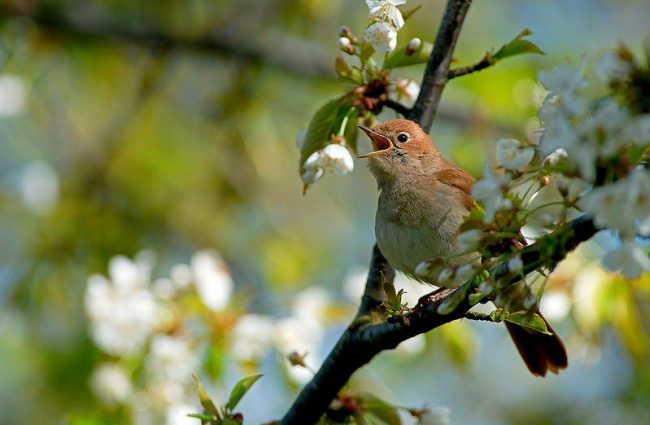
The nightingale is not attracted by external data, but it amazes him singing skill
Content
- 0.1 Content
- 1 Habitat
- 2 Characteristic
- 3 Nutrition
- 4 Reproduction
- 5 Nesting
- 6 Content at home
Content
- Habitat
- Characteristic
- Nutrition
- Breeding
- Nesting
- Home Content
At the moment, there are 13 species of nightingales in nature, of which the most popular are two species: southern (inhabits Africa, Asia and Europe) and the common or eastern nightingale (its habitat is Eastern Europe and Western Siberia). In the photo – the nightingale ordinary
Perhaps not a single bird is dedicated to so many verses and works like a nightingale. And for good reason. His singing is amazing variety of repertoire, power of sound and voice. In this case, completely surprisingly after hearing a delightful performance see this nondescript artist. Nightingale is not attracted by external data, but his singing skill is amazing. In addition, nightingale songs announce the coming of spring and the blooming of nature around, from which on the soul becomes warmer.

Southern nightingale, bird. A large photo shows this representative. It differs from the usual slightly brighter color and habitat
Habitat
At the moment, there are 13 species of nightingales in nature, of which the most popular are two species: southern (inhabits Africa, Asia and Europe) and the common or eastern nightingale (its habitat is Eastern Europe and Western Siberia). Nightingales are migratory birds. On the in winter they fly away from home, somewhere to the north of Africa, the south of Iran, Arabia Come back in mid-April when they start leaves appear on trees and insects crawl out. If someone doesn’t knows what a nightingale bird looks like – photos give about it representation.
Interesting! Males return home earlier females. Having found a suitable territory, the nightingale announces this with using a voiced song.

Homely appearance allows you to successfully hide in thick thickets. Nightingale used to live alone, he is secretive and careful
Characteristic
Nightingale bird, photo and description of which speak of a nondescript appearance, but amazing singing qualities, has following characteristics:
- The mass of the nightingale reaches 25 g, and the dimensions are 18 cm in length. is he only a little larger than a sparrow.
- Looking at the nightingale, you will never think that this is one of the best bird singers. Its plumage is most often chocolate brown colors with elements of gray. But big blacks stand out eyes.
- Homely appearance allows you to successfully hide in thick thickets. The nightingale used to live alone, he is secretive and cautious.
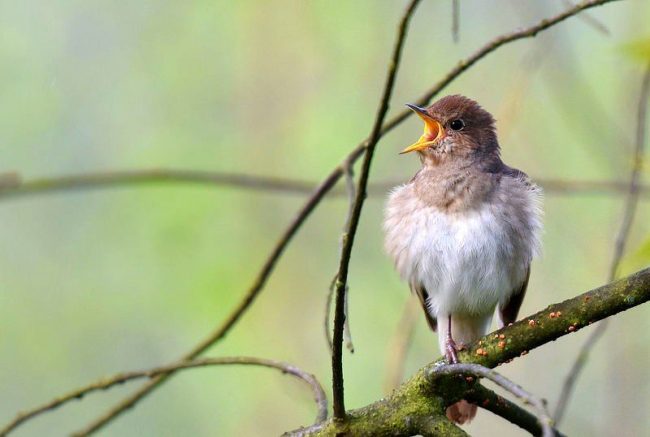
The nightingale’s repertoire is quite extensive. In his arsenal of 12 knees (i.e., elements of a song) that can be repeated and changed in places
- The nightingale became famous for its extraordinary singing skills. He begins to sing a few days after returning to his homeland, and sings all night.
- The nightingale’s repertoire is quite extensive. In his arsenal of 12 knees (i.e., elements of a song) that can be repeated and changed in places. Depending on the mood or weather, a nightingale song may be sad or funny. With his singing, he also warns of imminent danger, sounds the alarm.
- The nightingale’s concert lasts for hours, so the bird takes a comfortable posture: sits on a low twig, hunches a little, hangs wings, slightly raise the tail and begins to flood.
Interesting! Young nightingales take over the singing skills of the elders, imitating their performance. therefore often near one nightingale another settles, and there is a third. And the nightingale trills begin.
Nightingale nightlife is dedicated to singing, and daytime is dedicated to finding food. He runs on the ground, raking leaves and heaps, takes out caterpillars, bugs, worms, spiders, larvae and other animals. The nightingale is a nimble bird, so it can catch prey on the fly.
Nutrition
Nightingale nightlife is dedicated to singing, and daytime is dedicated to finding food. He runs on the ground, raking leaves and heaps, takes out caterpillars, bugs, worms, spiders, larvae and other animals. The nightingale is a nimble bird, so it can catch prey on the fly. In the summer, the bird diet is replenished with ripe berries and fruits, especially like the elderberry nightingale.
By the autumn, the nightingale’s nutrition becomes more intense, so the bird trying to stock up on fat for a long flight to winter.
Interesting! Nightingale eats pests that harm foliage and trees, thus, it saves plants from death, doing a great service for all of humanity.

Nightingale bird. Photo does not transmit singing, but at the end of the article there is beautiful nightingale video
Breeding
After the females have arrived, courtship games begin. Males compete in the art of singing, thus attracting ladies. It also happens that couples stay together from last year. When the time comes for mating, the male climbs deeper into the bush and courting his chosen one, flapping wings and tail, until she deigns to let him in. Such is the female proportion of females the nightingale that after mating she has to build a nest in alone, while her missus gets food.
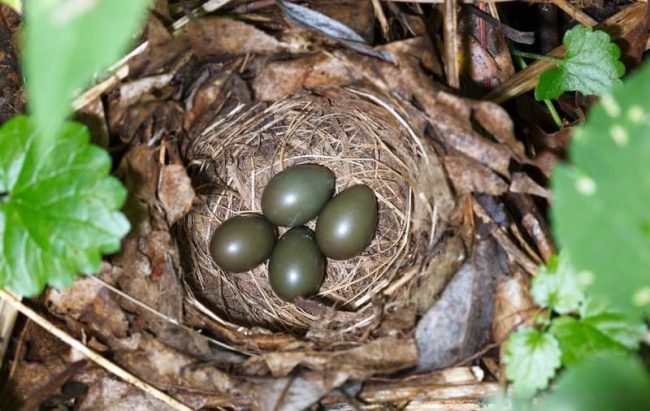
Arranging bird nests – akin to building a house – present art. Cup-shaped nightingale nest, it is arranged on ground or on small bushes and consists of dry leaves, stale since last year. Inside the house is lined with thin and dry blades of grass and twigs
Nesting
For the habitat, the nightingale chooses places with shrubs or thick grass, where you can hide from unexpected guests. Bushes and tree branches for our artist are not only scenic scaffolding, but also in places where you can notice danger from afar. There must also be nearby shady areas where fallen foliage lives a lot of insects, which regales the nightingale.
The nightingale is very fond of moisture, so the main places of his residence – river valleys, marshy areas, and also near the flowing and standing water. Often they can be found in sprawling gardens, parks.
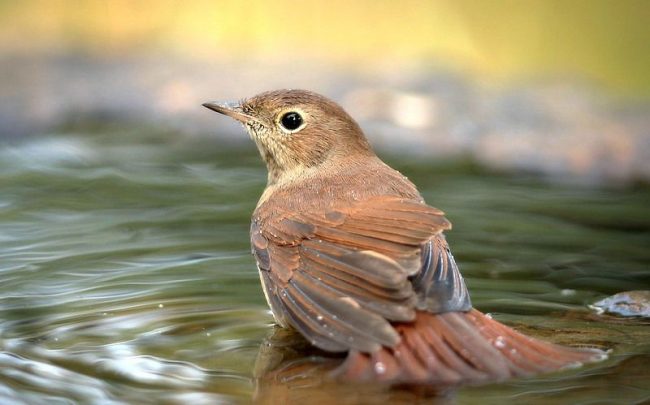
The nightingale is very fond of moisture, so the main places of his residence – river valleys, marshy areas, and also near the flowing and standing water. Often they can be found in sprawling gardens, parks
Arranging bird nests – akin to building a house – present art. Cup-shaped nightingale nest, it is arranged on ground or on small bushes and consists of dry leaves, stale since last year. Inside the house is lined with thin and dry blades of grass and twigs.
Soon after the nest is ready, the female begins to lay the eggs. In the clutch, 4 to 6 olive-brown eggs are obtained. The diameter of each egg is approximately 2 cm. Egg laying is carried out in late May – early June, and by the end of June, chicks appear. On the hatching eggs takes about 15 days, at this time the female only occasionally absent for rest and lunch. In late August – early September nightingale families with already strong chicks begin prepare for a winter flight so that in April – early May again come back home.

Hunting for nightingales in Russia from time immemorial was very popular, so at the end of the 19th century even a law prohibiting spring fishing for birds. Now this lesson common, but still there are lovers who keep at home these little singers
Home Content
Охота на соловьев в России из покон веков была очень популярна,так что в конце 19 века даже вступил в силу закон, запрещающийвесеннюю ловлю пернатых. Сейчас это занятие не стольраспространено, но все-таки есть любители, которые содержат домаthese little singers.
You need to catch the nightingale in the early days of his arrival at home, not later than the first week of May. By this time they still will not have time form pairs.
Nightingale is a free bird, not used to life in captivity, therefore very afraid of a new home. At first he can fight in the cage.
The nightingale’s cage should be special – not with iron, but wooden rods, with a cloth top, so that the recluse does not apply harm yourself. It is also recommended to cover the home with light cloth so that people didn’t scare the bird. Gradually, the bird gets used to captivity and recalls singing abilities. Already on the second – third day you can hear the nightingale trills coming from your apartment. IN at home, the nightingale, as in the wild, sings until July. Some amateur ornithologists prefer to keep nightingales only a couple months – while they sing, and in the middle of summer they are set free.
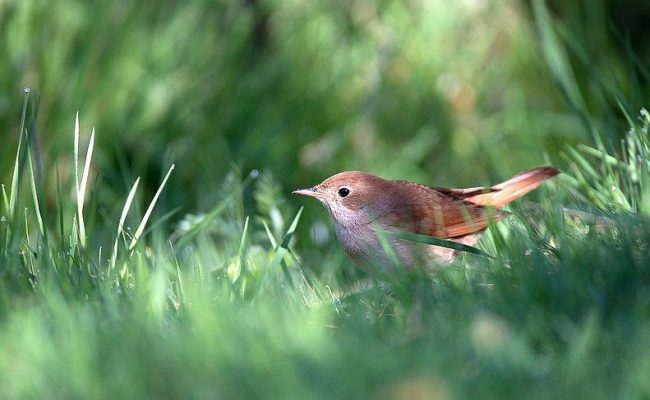
Outside the nightingale can live up to 12 years, and at home – only 2 to 3 years
As a nightingale will like flour worms and ant the eggs. If you plan to keep the nightingale year-round, it’s time to fall switch to a special feed – a mixture for insectivorous birds. Also in his diet should include grated carrots with ground white breadcrumbs, and as a main course – his favorite ant the eggs.
With proper maintenance and care by December, the nightingale again will take up singing, at first quietly, and with the first spring days – already in full force. A good nightingale master in captivity can live for several years.






